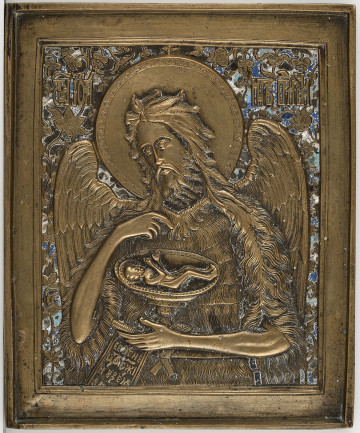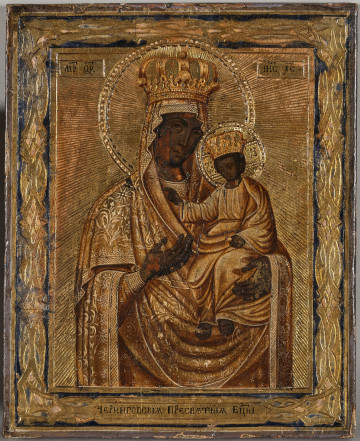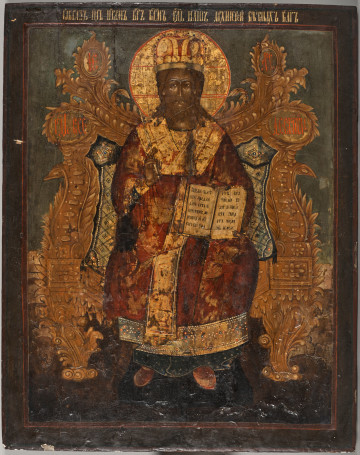
St. John the Baptist
20th century
Castle Museum in Łańcut
Part of the collection: Icons
Crucifixion. Objects of worship cast from metal alloys were initially brought to Rus from Byzantium. Locally crafted objects modelled after their Byzantine predecessors appeared in the 11th c. and became widespread in 12th-13th c. Important centres of their production were Kiev and later, Veliky Novgorod and Moscow. Frequently used objects of worship included crosses. In Byzantium, the cross was most commonly four-pointed with one crossbeam. This form was known and used in Rus (see S.12870MŁ). However, in the Rus tradition, an eight-pointed cross with three crossbeams became popular (see S.12791-12795MŁ; 12869MŁ; S.12871-12876MŁ). The earliest known image of such a cross is depicted on a 12th-century icon from Veliky Novgorod. The eight-pointed cross was considered the only allowable one among the followers of the old tradition, known as the Old Ritualists, who did not accept the liturgical reform started in Moscow orthodoxy in the middle of the 17th c. by Patriarch Nikon. The depiction of the eight-pointed cross usually consisted of two overlapping crosses. Christ was placed on the inner cross. In Rus, where the cross was venerated, it accompanied every Christian throughout their whole life, from birth to death. Relatively small crosses were worn hung on the chest and visible on clothing, hence called 'napiersny'. These crosses were usually crowned with the image of the Mandylion (see S.12864MŁ). On the top or the back of a napiersny cross was a loop through which a string could be pulled, as can be seen on the presented exhibit. On the ends of the central beam of the cross, there are the half-figures of those accompanying the Crucifixion: the Mother of God and Martha (the Gospels mention three women), as well as the youngest Apostle - John the Evangelist, and the Roman centurion Longinus, who came to believe in the Son of God. Teresa Bagińska-Żurawska https://orcid.org/0000-0002-9243-3967
Dimensions
height: 9.6 cm, width: 5.9 cm
Object type
Icons
Technique
cast, enamelling
Material
brass, varnish enamel
Origin / acquisition method
decyzja administracyjna
Creation time / dating
Creation / finding place
Owner
Castle Museum in Łańcut
Identification number
Location / status

20th century
Castle Museum in Łańcut

19th (?) century
Castle Museum in Łańcut

1800 — 1850
Castle Museum in Łańcut
DISCOVER this TOPIC
Museum of King Jan III's Palace at Wilanów
DISCOVER this PATH
Educational path